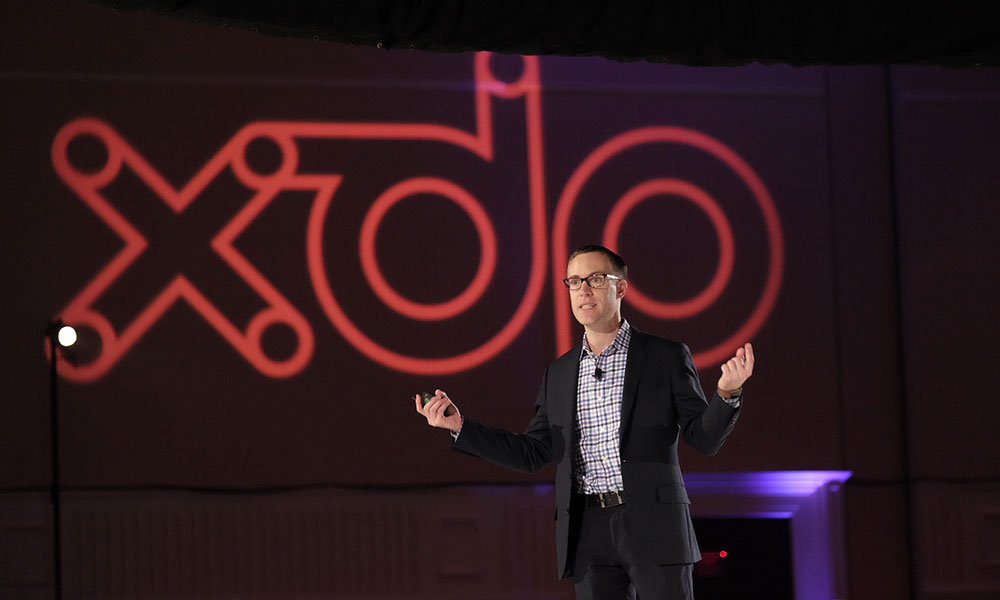
Wisdom of the Crowd: Takeaways From XDP
During day two of ASAE’s new Xperience Design Project event, expert faculty shared the solutions that association professionals had co-created the day before to improve meeting and event experiences.
Association professionals at ASAE’s inaugural Xperience Design Project spent all day Tuesday in small groups, led by expert faculty, discussing and finding practical solutions for improving meeting experiences. On Wednesday morning, faculty took the stage to share the insights and takeaways that had been co-created in each of XDP’s five zones.
Bring Home Life to Meetings
Michael Dominguez, chief sales officer for MGM Resorts International, who led the Location Zone, emphasized that associations must expand their definition of “location.”
“While we think of location typically as destination, it’s also the airport … and the hotel,” he said. “It’s those micro-locations within each of those locations that attendees see.”
He also urged the audience to bring experiences and elements from their everyday life to meeting design. “Think about floor plans today in residential housing. Everything’s about open concept,” Dominguez said. “And in that concept, you will get a kitchen, a living room, and a dining room.”
But, typically, when planners walk into a ballroom, they “only see the ballroom” and fail to see those spaces-within-the-spaces. “So start looking at spaces as you look at life,” he said.
Capitalize on Uniqueness
Jonathan Finkelstein, CEO of digital credentialing company Credly and leader of the Learning Zone, kicked off his recap by saying that associations have a unique opportunity.
“You get to work with your members for a lifetime,” he said. “Nobody else who is responsible for the content and the design of learning experiences has the potential to reach people for a lifetime.”
Finkelstein added that associations have the ability to see the future. “Because you look at the lifelong learning of your members, you also can look into the future and see what their needs are and will be as learners. That’s something that an employer or a college or a university can’t do,” he said.
To capitalize on those advantages, Finkelstein said associations need to focus on the six Cs: context, crowdsource, curation, choice, competencies, and credit.
Reveal the Rewards
Kiki L’Italien, CEO of Amplified Growth, and Eric Kuhn, chief marketing officer at Layer3 TV, who co-led the Marketing Zone, said that conference marketing is no longer about sharing features and benefits.
“[It is] about the different rewards,” Kuhn said. Then, he and L’Italien distilled them down to the four key ones.
First are functional rewards. “This is really conferencing 101,” he said. “This is what [attendees] get out of the conference, whether education experience or business opportunities.”
The second type is emotional. “Live events need make sure that they’re conveying that an attendee’s heart will be fulfilled just as much as the brain,” Kuhn said.
L’Italien shared the third reward: sensory. “If you can somehow make people feel, taste, touch … it’s going to be easier to sell a ticket,” she said.
Finally, there needs to be an expressive reward. “If you can communicate to people that it will make them more knowledgeable or raise their standing among colleagues, then you’re hitting on something,” she said.
Boost Human Connection
Reggie Aggarwal, CEO of Cvent, summed up his time leading the Technology Zone with this: “Technology needs to be a core competency of your association and its events.”
And, more important, associations need to embrace it in different ways before, during, and after an event to “amplify human connections.”
Pre-event, Aggarwal said, it’s all about “execution with the goal of increasing attendance.” He offered two ways to use technology to make this happen: segmenting your database and personalizing marketing efforts to individual people.
During the event, the focus should be not only on engagement onsite but also on expanding it beyond the meeting. “It’s a yearlong effort,” he said. “How do you engage your participants all year long?”
Once the event is over, “associations need to provide people with insights,” he said. One idea: Curate the best content from the event and share it with attendees and nonattendees.
Provoke Your Attendees
“When you think about experiences, start from the beginning,” said Experience Zone leader Jim Gilmore, management advisor at Strategic Horizons LLP.
For example, when attendees arrive onsite, they often have to wait in line. “No matter the technology, we have this paradigm where people are waiting in line by last name: A to L and M to Z,” he said.
Instead, he suggested having people line up by geography. Doing so will make these lines more conducive to conversation.
After urging associations to “provoke attendees and not just inform them,” Gilmore shared the four “Vs” of experience: voting, vibe, venue, and vet.
“Let’s do more to vet content going in, so that people don’t vent about it afterwards,” he said.
XDP host Lisa Kay Solomon summed up the faculty’s takeways with this call to action for attendees: “At the end of the day, we want to create something that your attendees wouldn’t ever be able to get at home,” she said. “Remember, you have the power to design experiences.”
Jonathan Finkelstein, the CEO of Credly, speaks at XDP on Wednesday. (Zoeica Images)






Comments